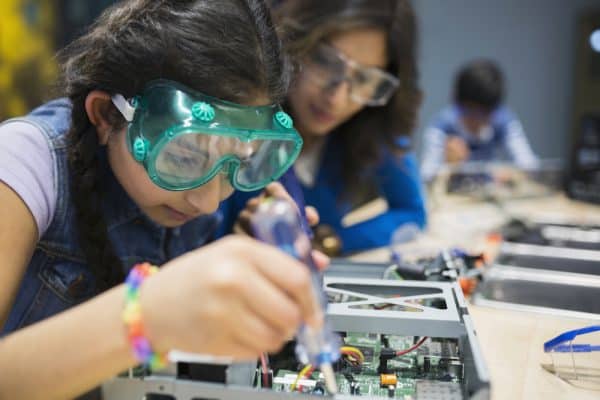Hosting a science fair at home can be a fun and educational experience for both children and adults. By organizing a DIY science fair, you have the opportunity to foster a love for scientific inquiry in your children, encourage creativity, and promote critical thinking skills. In this article, we will explore the various aspects of hosting a DIY science fair at home, from understanding the basics to planning and executing engaging science projects.

Understanding the Basics of a Science Fair
Before diving into the planning process, it is essential to grasp the fundamental concepts of a science fair. The purpose of a science fair is to provide an interactive platform for students to learn and showcase their scientific projects. It allows participants to investigate a scientific question and present their findings in an organized and educational manner. Additionally, science fairs foster collaboration, communication, and critical thinking skills.
Science fairs are not only about showcasing scientific projects but also about fostering a spirit of inquiry and discovery among students. They encourage young minds to explore the wonders of the natural world and apply scientific principles in a practical setting. By engaging in hands-on experiments and research, participants not only deepen their understanding of scientific concepts but also develop a sense of curiosity and creativity.
The Purpose of a Science Fair
Science fairs serve several purposes. They encourage students to explore scientific concepts through hands-on experiments and research. By participating in a science fair, students develop skills such as problem-solving, data analysis, and presentation skills. Furthermore, science fairs promote scientific literacy and stimulate an interest in STEM (science, technology, engineering, and mathematics) fields.
Moreover, science fairs provide a platform for students to interact with professionals in the scientific community, such as judges and mentors. This interaction not only allows students to receive valuable feedback on their projects but also exposes them to diverse perspectives and insights. It fosters a sense of community and collaboration, where individuals come together to celebrate and support the pursuit of knowledge and innovation.
Key Elements of a Science Fair
Every science fair consists of essential components that contribute to its success. These components include participant projects, judging criteria, clear guidelines and expectations, and opportunities for audience engagement. Participants must plan and execute their projects, effectively communicate their findings, and adhere to the rules and guidelines set forth by the organizers.
In addition to these key elements, science fairs often feature workshops, guest speakers, and interactive exhibits to enhance the overall experience for participants and attendees. These supplementary activities provide further opportunities for learning, networking, and inspiration. They create a dynamic and enriching environment where individuals of all ages can explore the wonders of science and technology.
Planning Your DIY Science Fair
Now that we understand the basics, let’s delve into the planning process for your DIY science fair. This section will guide you through choosing a theme, setting a date and schedule, and gathering the necessary materials for a successful event.
Choosing a Theme for Your Fair
The first step in planning your DIY science fair is selecting a theme. The theme will tie together the various projects and create a cohesive event. Consider choosing a theme that aligns with your child’s interests or the current scientific trends. Some popular themes include environmental science, biology, chemistry, physics, and technology.
When choosing a theme, it’s important to think about the potential impact it can have on the participants and attendees. For example, an environmental science theme can raise awareness about sustainability and inspire young minds to take action. A technology theme can showcase the latest innovations and spark curiosity in the field of engineering. By carefully selecting a theme, you can create an engaging and educational experience for everyone involved.
Setting a Date and Schedule
Once you have decided on a theme, it’s time to schedule your DIY science fair. Choose a date that allows sufficient time for participants to plan and execute their projects. Consider the availability of your guests and try to avoid significant conflicts. Create a detailed schedule that outlines the order of presentations, breaks, and any additional activities that you plan to incorporate into the fair.
When setting the date, it’s also important to consider the season and weather conditions. If you’re planning an outdoor science fair, you’ll want to choose a date when the weather is favorable. This will ensure that participants and attendees can comfortably enjoy the event without any disruptions. Additionally, consider any local events or holidays that may coincide with your chosen date, as they can affect attendance and availability.
Gathering Necessary Materials
After finalizing the theme and date, gather the necessary materials for your science fair. Depending on the projects, you may require items such as laboratory equipment, posters, display boards, project materials, and safety gear. Ensure that you have all the necessary supplies well in advance to avoid any last-minute rush or disappointment.
When gathering materials, it’s a good idea to reach out to local businesses, universities, or science organizations for support. They may be able to provide you with resources or sponsorships to help make your DIY science fair a success. Additionally, consider involving the participants in the process of gathering materials. This can be a great opportunity for them to learn about budgeting, resource management, and the importance of planning ahead.
Creating Engaging Science Projects
Now that the groundwork has been laid, let’s explore ways to create engaging science projects. This section will provide guidance on brainstorming project ideas, preparing experiments, and presenting the projects in a captivating manner.
Brainstorming Project Ideas
Encourage participants to think creatively and come up with project ideas that align with the selected theme. Brainstorming sessions can involve researching scientific topics, discussing ideas with peers, or seeking inspiration from science publications and websites. Emphasize the importance of originality and encourage participants to tackle real-world problems through their projects.
Preparing the Experiments
Once project ideas have been finalized, participants must prepare for their experiments. This involves conducting background research, formulating a hypothesis, planning the methodology, and gathering the necessary materials. Encourage participants to follow proper scientific procedures and maintain accurate records throughout their experimentation process.
Presenting the Projects
An important aspect of any science fair is the presentation of projects. Participants should create visually appealing display boards or posters that clearly communicate their project’s purpose, methods, results, and conclusions. Encourage creativity in the presentation format, such as including hands-on demonstrations, interactive elements, or multimedia components. Additionally, participants should be well-prepared to explain their projects, answer questions, and engage with the audience.
Setting Up Your Science Fair at Home
In this section, we will explore how to set up your science fair at home, ensuring an organized and interactive environment for participants and guests.
Designing the Layout
Before the event day, plan the layout of your science fair. Consider the available space and ensure that each participant has ample room to display their projects. Arrange tables, chairs, and display boards in an orderly manner, allowing for smooth traffic flow. A well-designed layout enhances the overall experience and makes it easier for guests to navigate through the event.
Setting Up the Projects
Prior to the science fair, ensure that participants have enough time to set up their projects. Provide guidelines on how to arrange their display boards, materials, and any interactive elements they have incorporated. Encourage participants to neatly organize their projects and make them visually appealing to captivate the audience’s attention.
Creating an Interactive Environment
To maximize the engagement and educational value of your DIY science fair, create an interactive environment. Incorporate hands-on activities or demonstrations related to the theme of your fair. Encourage guests to participate in experiments or explore science-related resources. Additionally, consider inviting guest speakers or experts in relevant scientific fields to share their knowledge and inspire participants.
By following these guidelines, you can successfully host a DIY science fair at home. Remember, the primary objective is to encourage curiosity, foster learning, and ignite a passion for science in the participants. Embrace the opportunity to create a memorable and enriching experience for all involved.



